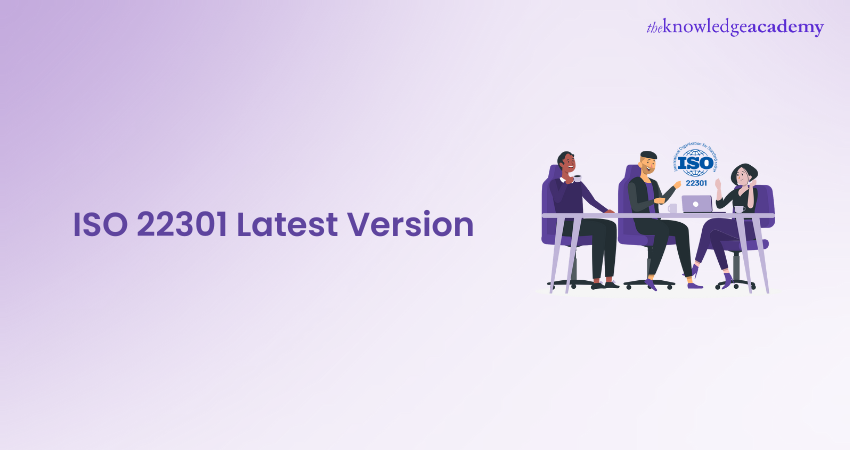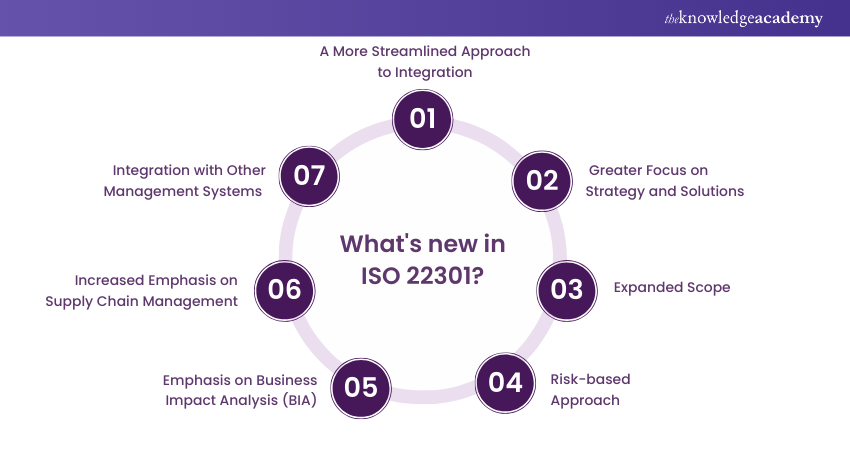We may not have the course you’re looking for. If you enquire or give us a call on +61 272026926 and speak to our training experts, we may still be able to help with your training requirements.
We ensure quality, budget-alignment, and timely delivery by our expert instructors.

There are numerous factors contributing to organisations facing various challenges capable of disrupting operations. From natural disasters to cyber-attacks and pandemics, ensuring Business Continuity has never been more challenging. That’s where the ISO 22301 Latest Version, comes into play.
It is a globally recognised framework developed by ISO that provides a structured approach to developing strategies and identifying potential risks to mitigate them. This is why approximately 6000 sites are ISO 22301 certified today, according to the ISO Survey of Management System Standard Certifications.
So, if you, too, wish to enhance your organisation’s ability to withstand disruptions, explore this blog to understand the ISO 22301 Latest Version and learn the expert analysis which will help you stay informed about any other advancements.
Table of contents
1) Understanding ISO 22301
2) Benefits of a Business Continuity Management System
3) What's new in ISO 22301?
a) A More Streamlined Approach to Integration
b) Greater Focus on Strategy and Solutions
c) Expanded Scope
d) Risk-based Approach
e) Emphasis on Business Impact Analysis (BIA)
f) Increased emphasis on Supply Chain Management
g) Integration with Other Management Systems
h) Acknowledging acceptable levels of activity
4) Conclusion
Understanding ISO 22301
ISO 22301 plays a crucial role in improving Business Continuity Management and is acknowledged on a global scale. In its core, 22301 offers a structured method for creating, executing, upholding, and continuously enhancing a Business Continuity Management System (BCMS).
The standard also describes the process of identifying possible risks, evaluating their consequences, and creating plans to reduce their impacts. It adopts a comprehensive method towards Business Continuity Management, covering different facets of an organisation's activities.
Additionally, it highlights the significance of leaders' dedication, involving stakeholders, and fostering a resilient culture. Therefore, ISO 22301 assists companies in setting up strong BCMS by navigating them through uncertainties and coming out stronger when faced with disruptions.
Benefits of a Business Continuity Management System
A Business Continuity Management System (BCMS) is one of the best ways for organisations to identify, assess, and plan for any disruptions. Let’s look at some of the benefits of a BCMS:
a) Business operations can be maintained during business operations
b) Operations can be quickly recovered if any interruption occurs
c) It can reduce the cost, time and impact of any disruption
d) It can help organisations install Risk Management strategies and risk mitigation tactics
e) BCMS helps in developing a culture of continual improvement
f) It can help the organisation to build and retain customer trust and loyalty
g) It can help the organisation comply with both legal and regulatory requirements of the industries
Learn Business Continuity with our ISO 22301 Certified Business Continuity Management Course – Register today!
What's new in ISO 22301?
ISO 22301 Latest Version has introduced several key updates and enhancements. These changes aim to provide organisations with an improved framework to manage disruptions and ensure the continuity of their operations. Here’s a closer look at what’s new in ISO 22301:

A More Streamlined Approach to Integration
The structure of ISO 22301 remains consistent, but the latest version offers a more streamlined approach. Several sections have been simplified, making alignment with other ISO standards, like ISO 9001, much smoother (with the context and scope clauses now more closely aligned). For those already holding an ISO certification, this update facilitates easier integration with existing systems, enhancing overall efficiency.
Greater Focus on Strategy and Solutions
One of the most significant changes in ISO 22301 is the removal of specific details, helping to align the standard more effectively with other ISOs. This shift emphasises the abilities and competence of those managing the system. ISO 22301 now adopts a broader, strategy-based approach, requiring organisations to develop not only high-level strategies but also clearly defined risk solutions.
This shift from strategies to solutions influences resource allocation and budget planning for the Business Continuity Management System. The updated standard also clarifies that risks and opportunities to be addressed are focused on the effectiveness of the management system rather than disruptions themselves.
Additionally, a new mandatory clause has been introduced, which was previously implied, requiring organisations to manage changes to their Business Continuity Management System in a structured way. To achieve this, businesses must consider the purpose and impact of the change, available resources for implementation, and how the change will affect the integrity of the system.
Expanded Scope
The latest version of ISO 22301 recognises the need to address a broader range of risks and potential disruptions. It considers emerging challenges such as cybersecurity threats, supply chain disruptions, and global pandemics. By incorporating these additional risks, the standard enables organisations to enhance their resilience in the face of evolving threats.
Risk-based Approach
The updated standard adopts a more comprehensive and risk-based approach to Business Continuity Management. It emphasises identifying, assessing, and managing risks that can impact an organisation’s ability to continue its critical operations. Thus, it allows organisations to prioritise their efforts and allocate resources effectively.
Emphasis on Business Impact Analysis (BIA)
The latest version emphasises conducting a thorough Business Impact Analysis (BIA). The BIA helps organisations understand the potential impact of disruptions on their critical functions and processes. This helps organisations develop targeted strategies to minimise the impact of disruptions.
Increased Emphasis on Supply Chain Management
It also recognises the importance of supply chain management in business continuity. ISO 22301 Latest Version highlights the need for organisations to assess and mitigate risks related to their supply chains. This can strengthen their overall resilience by incorporating supply chain considerations into their business continuity plans.
Gain skills to effectively respond to disruptive incidents with our ISO 22301 Training.
Integration with Other Management Systems
Lastly, the new version encourages the integration of the Business Continuity Management System (BCMS) with other management systems. This integration helps organisations align their business continuity efforts with other areas of their operations, such as Quality Management (ISO 9001) or Information Security Management (ISO 27001). As a result, they can achieve greater synergy, streamline processes, enhance overall efficiency in managing risks and ensure continuity.
Acknowledging Acceptable Levels of Activity
Another key change is the concept of minimum activity levels. Instead of identifying the minimum levels of products and services, the focus shifts to determining the minimum acceptable levels of activity. This reflects the minimum capacity needed to resume operations after a disruption. It acknowledges that your organisation may not return to its previous state right away.
Conclusion
ISO 22301 Latest Version brings valuable updates and enhancements to a dynamic industry. . By adopting ISO 22301, organisations can establish a robust Business Continuity Management System (BCMS). This enables them to proactively identify and mitigate risks, effectively respond to disruptions, and ensure the continuity of their critical operations.
Learn about basic principles and concepts of business continuity with our ISO 22301 Foundation Training.
Frequently Asked Questions

The ISO 22301:2019 Latest Version has a framework which explores strategies that organisations can implement them. These new updated versions allow organisations to mitigate disruptions and develop a strong Business Continuity policy.

With the newest ISO 22301:2019 Version, organisations can follow the framework to get effective incident response and recovery procedures if there are any disruptions. With these newest additions to the Standard, organisations can continue with their income stream. Their assets will also be protected in case of any unfortunate circumstances.

The Knowledge Academy takes global learning to new heights, offering over 30,000 online courses across 490+ locations in 220 countries. This expansive reach ensures accessibility and convenience for learners worldwide.
Alongside our diverse Online Course Catalogue, encompassing 17 major categories, we go the extra mile by providing a plethora of free educational Online Resources like News updates, Blogs, videos, webinars, and interview questions. Tailoring learning experiences further, professionals can maximise value with customisable Course Bundles of TKA.

The Knowledge Academy’s Knowledge Pass, a prepaid voucher, adds another layer of flexibility, allowing course bookings over a 12-month period. Join us on a journey where education knows no bounds.

The Knowledge Academy offers various ISO 22301 Training, including the ISO 22301 Foundation Course, ISO 22301 Lead Auditor, and ISO 22301 Certified Business Continuity Management Course. These courses cater to different skill levels, providing comprehensive insights into What is ISO.
Our ISO & Compliance blogs covers a range of topics related to ISO, offering valuable resources, best practices, and industry insights. Whether you are a beginner or looking to advance your ISO and Compliance skills, The Knowledge Academy's diverse courses and informative blogs have you covered.
Upcoming IT Service Management Resources Batches & Dates
Date
 ISO 22301 Foundation Training
ISO 22301 Foundation Training
Mon 10th Feb 2025
Mon 7th Apr 2025
Mon 2nd Jun 2025
Mon 11th Aug 2025
Mon 13th Oct 2025
Mon 8th Dec 2025







 Top Rated Course
Top Rated Course



 If you wish to make any changes to your course, please
If you wish to make any changes to your course, please


